Jiangshi – Terrifying Vicious Ancient Chinese Vampire In Disguise
A. Sutherland - AncientPages.com - Myths and legends of Europe, the Americas, China, Japan, and India describe terrible bloodsuckers that may differ in power and individual characteristics. Still, all of them fascinate people, and their vampiric fright knows no borders.
The Jiangshi vampire. Credit: Adobe Stock - FantasyLand86
Influential legends about Jiangshi (or Jiang shi) have long inspired a genre of literature, movies, and video games, especially in Hong Kong and East Asia.
Jiangshi - a genuinely terrifying undead Chinese creature - is described in Chinese legends and folklore as a half-vampire, half-zombie.
Typically, the Jiangshi (hopping vampire or hopping zombie) is depicted as a stiff corpse dressed in the official garments of the Qing dynasty (1644–1912), the last great dynastic empire to rule the region, with many powerful and long-lived rulers.
The belief that the human body can walk and function without personal consciousness or the soul is an idea that has captivated human beings for centuries. This idea is partially implausible as it may be more accurate than one thinks. Within Chinese culture and folklore, strange stories describe a creature known as the Jiangshi. It is believed to be as real, deadly, and terrifying as zombies.
Perhaps the Jiangshi is only an unrealistic, evil creature in Chinese folklore that was used in simple stories to scare children; however, the most remote villages of China blindly believe in the existence of this entity from the underworld and many similar ones.
Are not all the legends based on true events?
According to Chinese legends and folklore, Jiangshi – (‘jiang’ means hard) is a reanimated corpse of a victim of drowning, suicide, hanging, or smothering. These creatures are believed to be particularly vicious, ripping the heads and limbs of their victims.
The Jiangshi is so stiff that it cannot bend its limbs and body, so it moves by hopping, with its arms always outstretched, seeking out living creatures at night and killing them by devouring their ‘qi’ life force. It helps the Jiangshi to survive.
The Jiangshi vampire wears a uniform coat-like robe and round, traditional mandarin hat; they cannot speak and have pale skin, furry green hair, sharp, long claw-like fingernails, and an extremely long tongue.
The Jiangshi is not traditionally equated with the zombie but instead a vampire. During the day, the Jiangshi rests in either a coffin or hides in a dark, chilly cave.
According to one Qing Dynasty scholar, Ji Xiaolan (1724–1805), Jiangshi creatures can be divided into two groups: an old corpse that hasn’t decomposed or a freshly dead body returning to life. When Jiangshi’s corpse is recently deceased, the creature looks almost like an average human. Others, who have been decomposing for some time, have rotting flesh hanging off their yellowing bones. Jiangshi lore is very ancient, and the creature’s existence was taken very seriously by scholars in ancient China who speculated on how Jiangshi was created.
In the meantime, ancient Chinese sincerely believed in dangerous encounters with Jiangshi and tried to protect their homes.
Slats of wood 6 inches high were built under doors in the strange belief that these would keep out hopping zombies. To keep a Jiangshi in place, a slip of yellow paper with a spell written on it was usually also stuck on the corpses.
But the best way to eliminate this terrifying creature was to ask a Taoist priest for help. He was the only one who could balance their life and death with dark and light.
In popular Chinese mythology, reanimated corpses that hop around, killing living creatures to absorb life essence from their victims. Jiangshi is also pronounced Geung si, which is the Cantonese pronounciation for 'Hopping Corpse'. They are said to be created when a person's soul fails to leave the deceased's body.
The myth of "The Corpses who travel a Thousand Li" describes Tao wizards who transport corpses over long distances to hop on their own feet back to their hometown for proper burial. But there were also people who believed that hopping corpses were originally smugglers in disguise who wanted to scare off law enforcement officials
Hopping Corpses were a popular subject in Hong Kong movies during the 1980s;
some movies even featured both Chinese Hopping Corpse and "Western" zombie. In
the movies, hopping corpses can be put to sleep by putting on their foreheads a piece
of yellow paper with a spell written on it.
Generally in the movies these terrifying figures are dressed in imperial Qing Dynasty clothes, their arms are always outstretched due to rigor mortis. They can be evaded by holding one's breath, as they track living creatures by detecting their breathing.
Written by – A. Sutherland AncientPages.com Staff Writer
Updated on February 16, 2024
Copyright © AncientPages.com All rights reserved. This material may not be published, broadcast, rewritten or redistributed in whole or part without the express written permission of AncientPages.com
Expand for referencesReferences:
K.W. Bishop, 'How zombies conquered popular culture'.
More From Ancient Pages
-
 Was There An Explosion In The Great Pyramid In Antiquity?
Featured Stories | Aug 6, 2014
Was There An Explosion In The Great Pyramid In Antiquity?
Featured Stories | Aug 6, 2014 -
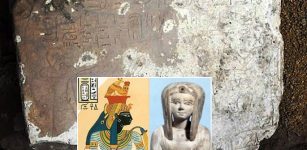 Limestone Stela Of Liberation Discovered In Kom Ombo Temple In Aswan, Egypt
Archaeology | Oct 17, 2018
Limestone Stela Of Liberation Discovered In Kom Ombo Temple In Aswan, Egypt
Archaeology | Oct 17, 2018 -
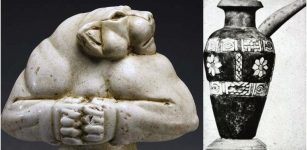 Mesopotamian City Jemdet Nasr Dated To 3100–2900 BC: Sophisticated Irrigation Techniques And Earliest Cylinder Seals
Featured Stories | Dec 18, 2016
Mesopotamian City Jemdet Nasr Dated To 3100–2900 BC: Sophisticated Irrigation Techniques And Earliest Cylinder Seals
Featured Stories | Dec 18, 2016 -
 3-D Reconstructions Of Three Wooden Boats Found At Ancient Port In Italy
Archaeology | Jun 23, 2020
3-D Reconstructions Of Three Wooden Boats Found At Ancient Port In Italy
Archaeology | Jun 23, 2020 -
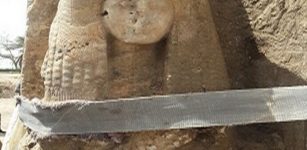 Archaeologists Unearthed Alabaster Statue Of Queen Tiye In Luxor, Egypt
Archaeology | Mar 24, 2017
Archaeologists Unearthed Alabaster Statue Of Queen Tiye In Luxor, Egypt
Archaeology | Mar 24, 2017 -
 Bog Body Of The Elling Woman: Was She Sacrificed To The Gods Because Of Climate Change?
Civilizations | Mar 25, 2017
Bog Body Of The Elling Woman: Was She Sacrificed To The Gods Because Of Climate Change?
Civilizations | Mar 25, 2017 -
 Ancient Fresco Tomb Dated A 1000-Years Ago Was Accidentally Discovered In Northern China
Archaeology | May 5, 2020
Ancient Fresco Tomb Dated A 1000-Years Ago Was Accidentally Discovered In Northern China
Archaeology | May 5, 2020 -
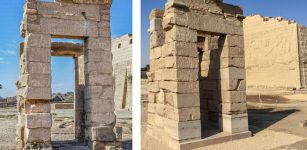 Ancient Egyptian Monuments Threatened By Climate Change Restored By Oriental Institute
News | Mar 9, 2023
Ancient Egyptian Monuments Threatened By Climate Change Restored By Oriental Institute
News | Mar 9, 2023 -
 12th Century Idol Of Vishnumurthy Unearthed In Abandoned Well Near Udupi, India
Archaeology | Feb 26, 2021
12th Century Idol Of Vishnumurthy Unearthed In Abandoned Well Near Udupi, India
Archaeology | Feb 26, 2021 -
 Extraordinary Discovery: Clay Vessel With Sour Soup For The Gods Found In Medieval Hut
Archaeology | Jun 4, 2017
Extraordinary Discovery: Clay Vessel With Sour Soup For The Gods Found In Medieval Hut
Archaeology | Jun 4, 2017 -
 Thousands Magnificent Jade Artifacts Discovered In Han Dynasty Tombs – China’s Golden Age In New Light
Archaeology | Jul 23, 2020
Thousands Magnificent Jade Artifacts Discovered In Han Dynasty Tombs – China’s Golden Age In New Light
Archaeology | Jul 23, 2020 -
 Deception And Hidden Truth – Ancient Struggle Of The Eagle And Serpent – Part 2
Ancient Mysteries | Sep 6, 2019
Deception And Hidden Truth – Ancient Struggle Of The Eagle And Serpent – Part 2
Ancient Mysteries | Sep 6, 2019 -
 Huge 36-Million-Year-Old Skull Of Fearsome Marine Monster Discovered In Peru
Fossils | Mar 21, 2022
Huge 36-Million-Year-Old Skull Of Fearsome Marine Monster Discovered In Peru
Fossils | Mar 21, 2022 -
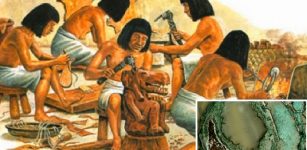 What Ancient Civilization Discovered Metallurgy?
Ancient Technology | Sep 19, 2017
What Ancient Civilization Discovered Metallurgy?
Ancient Technology | Sep 19, 2017 -
 Chacmool (‘Chac-Mool’) – Intriguing Pre-Columbian Statue Found At Many Ancient Sites In Mesoamerica
Featured Stories | May 22, 2021
Chacmool (‘Chac-Mool’) – Intriguing Pre-Columbian Statue Found At Many Ancient Sites In Mesoamerica
Featured Stories | May 22, 2021 -
 Binary Code Was Used In Ancient India And Polynesia Long Before Leibnitz Invented It
Ancient Technology | Sep 28, 2017
Binary Code Was Used In Ancient India And Polynesia Long Before Leibnitz Invented It
Ancient Technology | Sep 28, 2017 -
 Rare 17th Century Wreck Of Dutch Fluit Ship Found In The Baltic Sea By Finnish Divers
News | Aug 25, 2020
Rare 17th Century Wreck Of Dutch Fluit Ship Found In The Baltic Sea By Finnish Divers
News | Aug 25, 2020 -
 Did Lead Pollution Cause IQ Declines Among Ancient Romans?
Places | Jan 8, 2025
Did Lead Pollution Cause IQ Declines Among Ancient Romans?
Places | Jan 8, 2025 -
 Unexplained Historical Mass Disappearances – Where Did They Go? – Part 2
Featured Stories | Jun 4, 2019
Unexplained Historical Mass Disappearances – Where Did They Go? – Part 2
Featured Stories | Jun 4, 2019 -
 Isle Of May Was A Pictish Healing Center – Monks Used Herbs To Treat Sick And Dying People
Archaeology | Feb 16, 2018
Isle Of May Was A Pictish Healing Center – Monks Used Herbs To Treat Sick And Dying People
Archaeology | Feb 16, 2018

